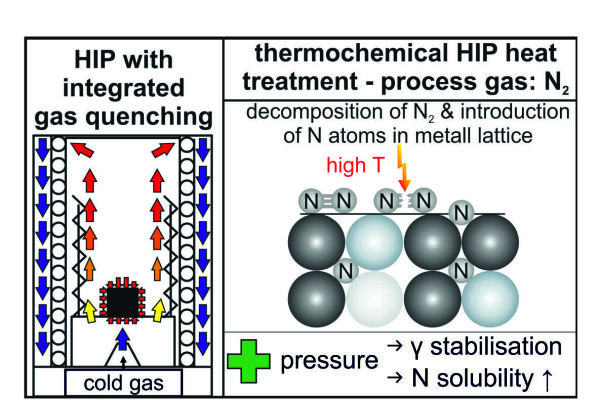2025-07-04

In a recent publication in Materials Today Communications, we present a novel heat treatment concept. As part of a DFG transfer project with Quintus Technologies, thermochemical nitriding in a hot isostatic press (HIP) with integrated gas quenching (URQ®) was successfully realised for the first time. The process was realised in a HIP system equipped with a graphite furnace, the only system worldwide to combine a graphite furnace and the URQ® technology.
The investigations focussed on the systematic nitrogen enrichment in the austenitic steel X2CrNiMo17-12-2 (1.4404 / AISI 316L). An interstitial nitrogen uptake of up to 0.7 wt% was achieved in the austenitic lattice, which significantly increased the hardness compared to the conventional state.
The results demonstrate the potential of the process for the precise modification of near-surface microstructures and the application-specific adjustment of mechanical and corrosive properties. Future work will investigate the use of specific gas mixtures to adjust the microstructure even more precisely - especially for thin-walled, additively manufactured components, for which thermochemical HIP nitriding opens up new possibilities in microstructural design.

In a recent publication in Materials Today Communications, we present a novel heat treatment concept. As part of a DFG transfer project with Quintus Technologies, thermochemical nitriding in a hot isostatic press (HIP) with integrated gas quenching (URQ®) was successfully realised for the first time. The process was realised in a HIP system equipped with a graphite furnace, the only system worldwide to combine a graphite furnace and the URQ® technology.
The investigations focussed on the systematic nitrogen enrichment in the austenitic steel X2CrNiMo17-12-2 (1.4404 / AISI 316L). An interstitial nitrogen uptake of up to 0.7 wt% was achieved in the austenitic lattice, which significantly increased the hardness compared to the conventional state.
The results demonstrate the potential of the process for the precise modification of near-surface microstructures and the application-specific adjustment of mechanical and corrosive properties. Future work will investigate the use of specific gas mixtures to adjust the microstructure even more precisely - especially for thin-walled, additively manufactured components, for which thermochemical HIP nitriding opens up new possibilities in microstructural design.